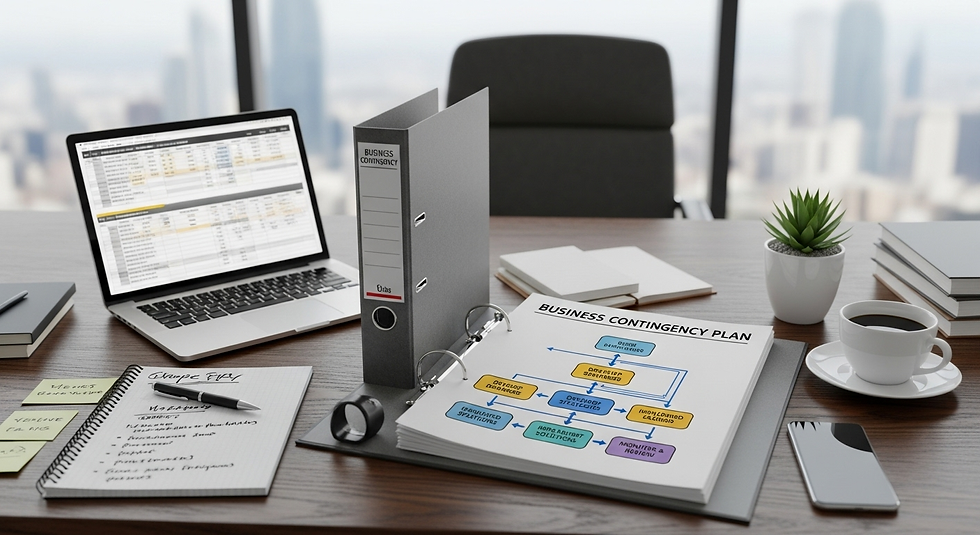Business Continuity Training for Employees: A Practical Guide to Building a Resilient Business Contingency Plan
- rebekahh84
- Sep 17
- 4 min read

When disruption strikes, organizations that invest in business continuity training for employees recover faster and experience measurably less downtime, with industry analyses often citing that unprepared businesses face prolonged outages that significantly increase cost and customer churn. A practical program aligns day-to-day roles with the business contingency plan, while targeted business continuity consulting can accelerate maturity and close high‑risk gaps efficiently.
Key takeaway, training builds reflexes, plans supply direction, and expert guidance ensures both are tested, current, and auditable.
What Is Business Continuity Training for Employees?
Business continuity training for employees equips teams with the awareness, role-based skills, incident communication discipline, and hands-on exercise experience needed to perform under pressure. The goal is operational resilience, not just policy awareness, so training is anchored to realistic scenarios and clear decision paths.
The connection to the business contingency plan is direct. Training turns plan artifacts into action by clarifying who does what, how to escalate, and when to execute recovery steps aligned to recovery time objective and recovery point objective targets. When staff understand how their tasks influence RTO and RPO, response becomes faster, more coordinated, and auditable.Also Read : How to Train Employees for Business Continuity and Crisis Response?
Linking Training to the Business Contingency Plan
The most reliable programs map training modules to the core components of the business contingency plan. That typically includes risk assessment, business impact analysis, recovery strategies, incident communications, and plan testing with continuous improvement loops.
A simple, repeatable cascade keeps everything aligned: policy, roles and responsibilities, playbooks, drills, and after‑action reviews. Embedding tabletop exercise scenarios and an incident communication playbook into this cascade ensures that training reinforces the exact workflows the plan prescribes, not generic theory.
How to Build an Effective Business Contingency Program
Role-Based Learning Paths
Different roles require different depth. Executives need decision thresholds and stakeholder communication, incident managers need cross-functional coordination skills, recovery team members need technical runbooks, and general staff need clear safety, reporting, and continuity procedures. A lightweight employee emergency preparedness checklist helps every role know first actions and handoffs.
Blended Learning and Simulations
The most resilient teams blend microlearning, tabletop exercises, and full-scale drills to harden muscle memory. Short modules teach concepts, tabletops test judgment under time pressure, and simulations validate technical recoverability end to end. Organizations that exercise regularly see meaningfully lower mean time to restore and stronger stakeholder confidence.
Metrics That Matter
Measure training completion, exercise participation, time to notify, time to restore, and post-incident improvements captured in corrective action plans. Track plan and playbook usage during exercises, identify failure modes, and use findings to refine both content and coaching. Reliable metrics make progress visible and justify targeted investment.

When to Use Business Continuity Consulting
Accelerating Maturity
External specialists can expedite complex steps such as running enterprise-wide BIAs, building realistic scenario catalogs, and instituting governance that keeps plans living and current. The right partner translates regulatory expectations into right-sized controls, reduces friction across departments, and ensures testing is risk‑based rather than checkbox‑driven.
Technology Enablement
Expert guidance helps select and implement tools for mass notification, plan management, exercise orchestration, and audit-ready reporting. Engagements often include integration of crisis communications, asset inventories, vendor dependencies, and data protection guardrails with clear ownership and version control.
Note on adjacent capabilities: pairing a seasoned disaster recovery consultant with continuity practitioners closes the loop between process resilience and IT recoverability. For highly technical recoveries, targeted disaster recovery consulting services ensure backups, failover, and restoration steps are validated in real conditions, not just documented.

Implementation Roadmap
90-Day Quick Start
Inventory critical processes and define RTO and RPO thresholds that leadership endorses.
Assign roles, publish one-page quick-reference guides, and share an incident communication playbook.
Launch awareness training, run a tabletop exercise, collect gaps, and prioritize fixes with owners and dates.
12-Month Scale-Up
Expand exercise scope from single-team to cross-functional and supplier-inclusive scenarios.
Automate notifications and status tracking, and embed lessons learned into runbooks within two weeks of each drill.
Integrate vendor and site dependencies, formalize audit cadence, and align performance reviews to continuity responsibilities.
These focus areas drive clarity in both technical and non‑technical audiences.
Conclusion
Business continuity training for employees is the multiplier that turns plans into performance, connecting people, process, and technology to hit recovery targets with confidence. For organizations seeking expert acceleration and proven playbooks, Business Contingency Group brings comprehensive emergency management expertise, hands-on training, and technology enablement to build resilience faster.
Ready to stress-test the plan and upskill teams, start a conversation with Business Contingency Group today for a tailored roadmap and high‑impact exercises that deliver results.
FAQs
1. How often should business continuity training for employees be conducted?
At minimum, run awareness annually, role-based refreshers twice per year, and exercises quarterly for critical functions, with retraining after any incident or major change.
2. What is the difference between a business contingency plan and a business continuity plan?
The terms are closely related, with contingency emphasizing alternatives and workarounds, and continuity emphasizing sustaining operations and recovery, so most organizations manage both under a unified framework.
3. Do small businesses need business continuity consulting?
Yes, a focused engagement can right‑size plans, accelerate BIAs and exercises, and avoid overengineering while meeting customer and regulatory expectations efficiently.




Comments